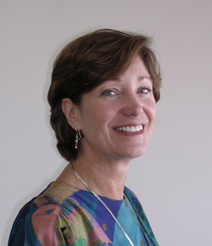Verna Harrison,
Keith Campbell Foundation
for the Environment
By Martie Callaghan
Investment manager
Keith Campbell of Campbell and Company in Baltimore was a youth
when he moved to the area because his father loved the water and
fishing. Years later, as a committed environmentalist, Campbell
located his business in Maryland because of the Chesapeake Bay.
"The environment has always been a personal focus of mine as what
I enjoy in life," he says, "[but] the Bay needs a lot of help.
To see the state it is in now is very disturbing."
 Campbell
is working through the offices of the Keith Campbell Foundation
for the Environment to benefit habitat restoration, environmental
education and advocacy. Last spring, when the work of the foundation
had reached a point where he felt he was unable to handle it all
himself, he hired Verna Harrison, former assistant secretary for
the Chesapeake Bay and watershed programs for the Maryland Department
of Natural Resources (DNR). Campbell
is working through the offices of the Keith Campbell Foundation
for the Environment to benefit habitat restoration, environmental
education and advocacy. Last spring, when the work of the foundation
had reached a point where he felt he was unable to handle it all
himself, he hired Verna Harrison, former assistant secretary for
the Chesapeake Bay and watershed programs for the Maryland Department
of Natural Resources (DNR).
Campbell has complete trust that Harrison's 25 years of environmental
experience will enable her to identify the most significant opportunities
for making a difference with foundation funds. "I called all of
the secretaries she had worked under, and they uniformly gave
her nines and tens," he says. "She is very talented and well-respected
by people at DNR."
Harrison counts herself fortunate to have worked with three secretaries
of DNR: Secretary Torrey Brown, Secretary John Griffin and Secretary
Chuck Fox. "[They are] just really smart people [who are] willing
to let those around them come up with ideas, take some risks and
move forward," Harrison says. "I think Maryland has been a leader
in the Bay area in this regard."
Highlights of Harrison's service with DNR include the management
of fisheries during the ban on rockfish harvest in the mid-80s.
She served as assistant secretary for resource management and
enforcement at that time.
More recently, Harrison served as assistant secretary for Chesapeake
Bay and watershed programs and, in that capacity, coordinated
all Maryland state departmental positions on Chesapeake Bay restoration
and protection issues and led the multi-jurisdictional effort
to develop the 2000 Chesapeake Bay Agreement.
In light of the tremendous importance of states working together,
part of Harrison's job over the last 20 years has been to coordinate
the relationships on Bay issues among Maryland, Pennsylvania and
Virginia for the office of the Governor of Maryland. "Think about
Maryland as the middle layer of a sandwich," she says, "and what
happens in Pennsylvania as far as pollution coming down the Susquehanna
River affects Maryland, and what happens in Virginia as far as
crab harvests, etc., affects our resources in Maryland."
While there has been great progress made in raising awareness
that individual action can make a difference in protecting the
Chesapeake Bay, Harrison emphasizes that we still have a long
way to go. "We have many, many things that need to be done to
continue to protect the Bay. When you consider the amount of population
growth in Annapolis, Severna Park and south county-in just this
area, let alone all of Maryland's shorelines---it is truly amazing
that the Bay has improved at all."
The goal of the Keith Campbell Foundation, under Harrison's direction,
is to leverage the funds so as to create the most significant
impact. "For example," she explains, "most government funds require
a match. The federal government gives you money to do something.
It normally requires that a certain percentage, often 50 percent,
be matched by the state or private sector. With state funds as
tight as they are right now, private sector funding is even more
important."
Beyond that, the foundation also looks to help coordinate how
funds are spent. Another example, Harrison explains, might be
the funding of programs to restore the underwater grasses that
are critical for crabs and water quality. Many different programs
and interests exist right now to work on that project, and the
Campbell Foundation has helped coordinate that effort so that
there is not duplication.
A portion of the foundation's funds is earmarked for the sustaining
of organizations that directly engage the public, such as the
Chesapeake Bay Foundation and the Alliance for the Chesapeake
Bay. Through these groups, volunteers are helping by growing oysters,
cleaning up streams and planting trees.
Another effort of the foundation which directly impacts the Annapolis
environment is the support of "riverkeepers." These groups consist
of very committed individuals who work with landowners who may
see something happening along the edge of the water which they
believe may be in violation of the critical areas law, for example.
Rather than become directly involved, the landowner can call one
of the riverkeepers to look into the matter. Riverkeeper groups
are forming now on the South River and are already operating on
the Severn, Chester and Patapsco rivers.
A new and exciting project for the Keith Campbell Foundation involves
a bulkhead alternative known as "soft practices." In areas where
the wave action is not too strong, property owners can either
plant grass along the edge of the water or use bundles of tightly
twisted hay and other types of material to form a habitat-friendly
kind of blockage which will not only keep the soil on the property
but will provide an environment for turtles and other creatures
to live. These practices continue to evolve as new technologies
are introduced. It's the proverbial win-win: much cheaper for
the landowner and much better for the environment.
The Keith Campbell Foundation will be helping to fulfill the provisions
of the new Bay agreement which calls for every child to have an
outdoor education experience before graduating from high school.
"In Maryland, we would like to have three of those," says Harrison,
"one in each section of their educational development: primary,
middle and high school. We will help to find where the gaps are
in the state of Maryland---that is, which counties are under-served---and
then see if we can develop some coalitions for helping there...I
think environmental education is one of the most important things
we can do.
"In Maryland, almost everybody lives within 10 minutes of a stream
or a creek. Even if you don't live right on the water, what you
do makes a difference."
 Martie
Callaghan is a freelance writer and native Marylander who
enjoys spending time with her five grandchildren. Martie
Callaghan is a freelance writer and native Marylander who
enjoys spending time with her five grandchildren.
|
Back
|

